Managing Financial Resources: A Report on Stratford Yachts' Finances
VerifiedAdded on 2021/01/01
|13
|2775
|133
Report
AI Summary
This report provides a detailed analysis of financial resource management, focusing on Stratford Yachts Limited. It begins by differentiating between financial and management accounting, highlighting their roles and key differences. The report then explores the purpose of various financial statements in both profit and non-profit organizations. A significant portion is dedicated to identifying different stakeholder groups, such as customers, employees, investors, suppliers, communities, and governments, and detailing their respective information requirements. Furthermore, the report presents a financial analysis of Stratford Yachts Limited, including ratio calculations and an assessment of the company's performance in terms of profitability and liquidity. The analysis covers various ratios, such as net profit margin, return on capital employed, asset turnover, and liquidity ratios, comparing them to industry standards. The report concludes with an overview of the company's financial position and recommendations for improvement.

MANAGING FINANCIAL
RESOURCES
RESOURCES
Paraphrase This Document
Need a fresh take? Get an instant paraphrase of this document with our AI Paraphraser
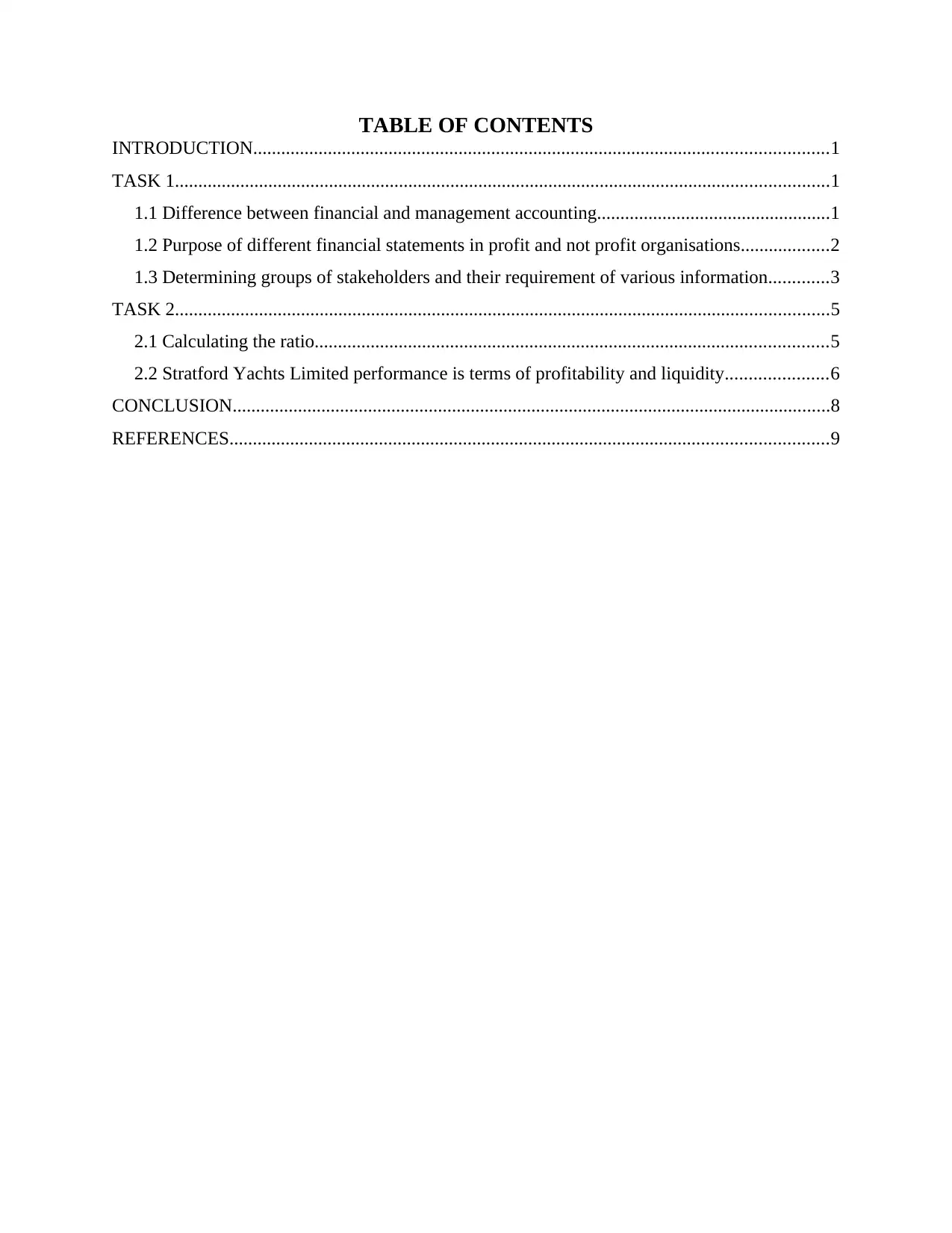
TABLE OF CONTENTS
INTRODUCTION...........................................................................................................................1
TASK 1............................................................................................................................................1
1.1 Difference between financial and management accounting..................................................1
1.2 Purpose of different financial statements in profit and not profit organisations...................2
1.3 Determining groups of stakeholders and their requirement of various information.............3
TASK 2............................................................................................................................................5
2.1 Calculating the ratio..............................................................................................................5
2.2 Stratford Yachts Limited performance is terms of profitability and liquidity......................6
CONCLUSION................................................................................................................................8
REFERENCES................................................................................................................................9
INTRODUCTION...........................................................................................................................1
TASK 1............................................................................................................................................1
1.1 Difference between financial and management accounting..................................................1
1.2 Purpose of different financial statements in profit and not profit organisations...................2
1.3 Determining groups of stakeholders and their requirement of various information.............3
TASK 2............................................................................................................................................5
2.1 Calculating the ratio..............................................................................................................5
2.2 Stratford Yachts Limited performance is terms of profitability and liquidity......................6
CONCLUSION................................................................................................................................8
REFERENCES................................................................................................................................9
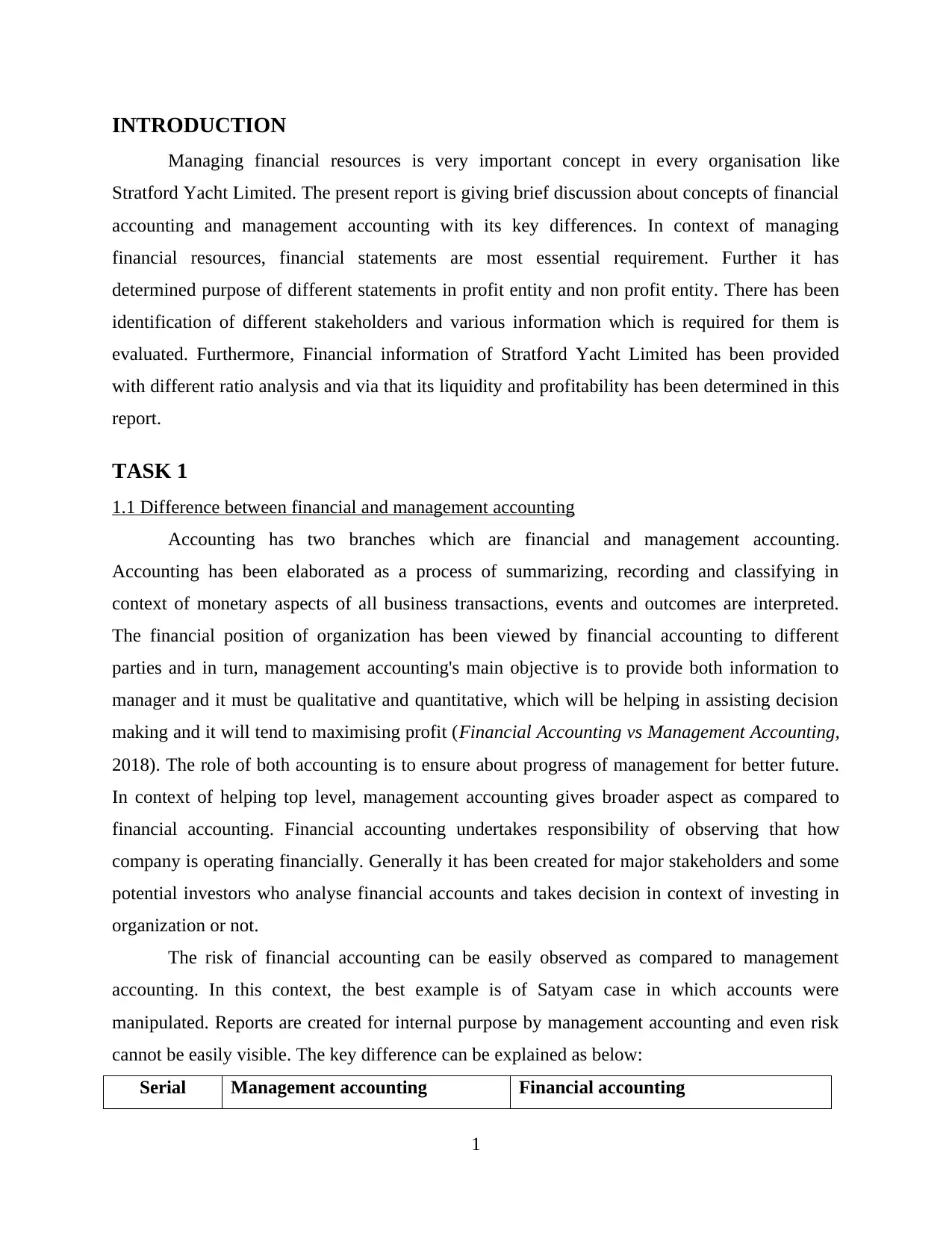
INTRODUCTION
Managing financial resources is very important concept in every organisation like
Stratford Yacht Limited. The present report is giving brief discussion about concepts of financial
accounting and management accounting with its key differences. In context of managing
financial resources, financial statements are most essential requirement. Further it has
determined purpose of different statements in profit entity and non profit entity. There has been
identification of different stakeholders and various information which is required for them is
evaluated. Furthermore, Financial information of Stratford Yacht Limited has been provided
with different ratio analysis and via that its liquidity and profitability has been determined in this
report.
TASK 1
1.1 Difference between financial and management accounting
Accounting has two branches which are financial and management accounting.
Accounting has been elaborated as a process of summarizing, recording and classifying in
context of monetary aspects of all business transactions, events and outcomes are interpreted.
The financial position of organization has been viewed by financial accounting to different
parties and in turn, management accounting's main objective is to provide both information to
manager and it must be qualitative and quantitative, which will be helping in assisting decision
making and it will tend to maximising profit (Financial Accounting vs Management Accounting,
2018). The role of both accounting is to ensure about progress of management for better future.
In context of helping top level, management accounting gives broader aspect as compared to
financial accounting. Financial accounting undertakes responsibility of observing that how
company is operating financially. Generally it has been created for major stakeholders and some
potential investors who analyse financial accounts and takes decision in context of investing in
organization or not.
The risk of financial accounting can be easily observed as compared to management
accounting. In this context, the best example is of Satyam case in which accounts were
manipulated. Reports are created for internal purpose by management accounting and even risk
cannot be easily visible. The key difference can be explained as below:
Serial Management accounting Financial accounting
1
Managing financial resources is very important concept in every organisation like
Stratford Yacht Limited. The present report is giving brief discussion about concepts of financial
accounting and management accounting with its key differences. In context of managing
financial resources, financial statements are most essential requirement. Further it has
determined purpose of different statements in profit entity and non profit entity. There has been
identification of different stakeholders and various information which is required for them is
evaluated. Furthermore, Financial information of Stratford Yacht Limited has been provided
with different ratio analysis and via that its liquidity and profitability has been determined in this
report.
TASK 1
1.1 Difference between financial and management accounting
Accounting has two branches which are financial and management accounting.
Accounting has been elaborated as a process of summarizing, recording and classifying in
context of monetary aspects of all business transactions, events and outcomes are interpreted.
The financial position of organization has been viewed by financial accounting to different
parties and in turn, management accounting's main objective is to provide both information to
manager and it must be qualitative and quantitative, which will be helping in assisting decision
making and it will tend to maximising profit (Financial Accounting vs Management Accounting,
2018). The role of both accounting is to ensure about progress of management for better future.
In context of helping top level, management accounting gives broader aspect as compared to
financial accounting. Financial accounting undertakes responsibility of observing that how
company is operating financially. Generally it has been created for major stakeholders and some
potential investors who analyse financial accounts and takes decision in context of investing in
organization or not.
The risk of financial accounting can be easily observed as compared to management
accounting. In this context, the best example is of Satyam case in which accounts were
manipulated. Reports are created for internal purpose by management accounting and even risk
cannot be easily visible. The key difference can be explained as below:
Serial Management accounting Financial accounting
1
⊘ This is a preview!⊘
Do you want full access?
Subscribe today to unlock all pages.

Trusted by 1+ million students worldwide
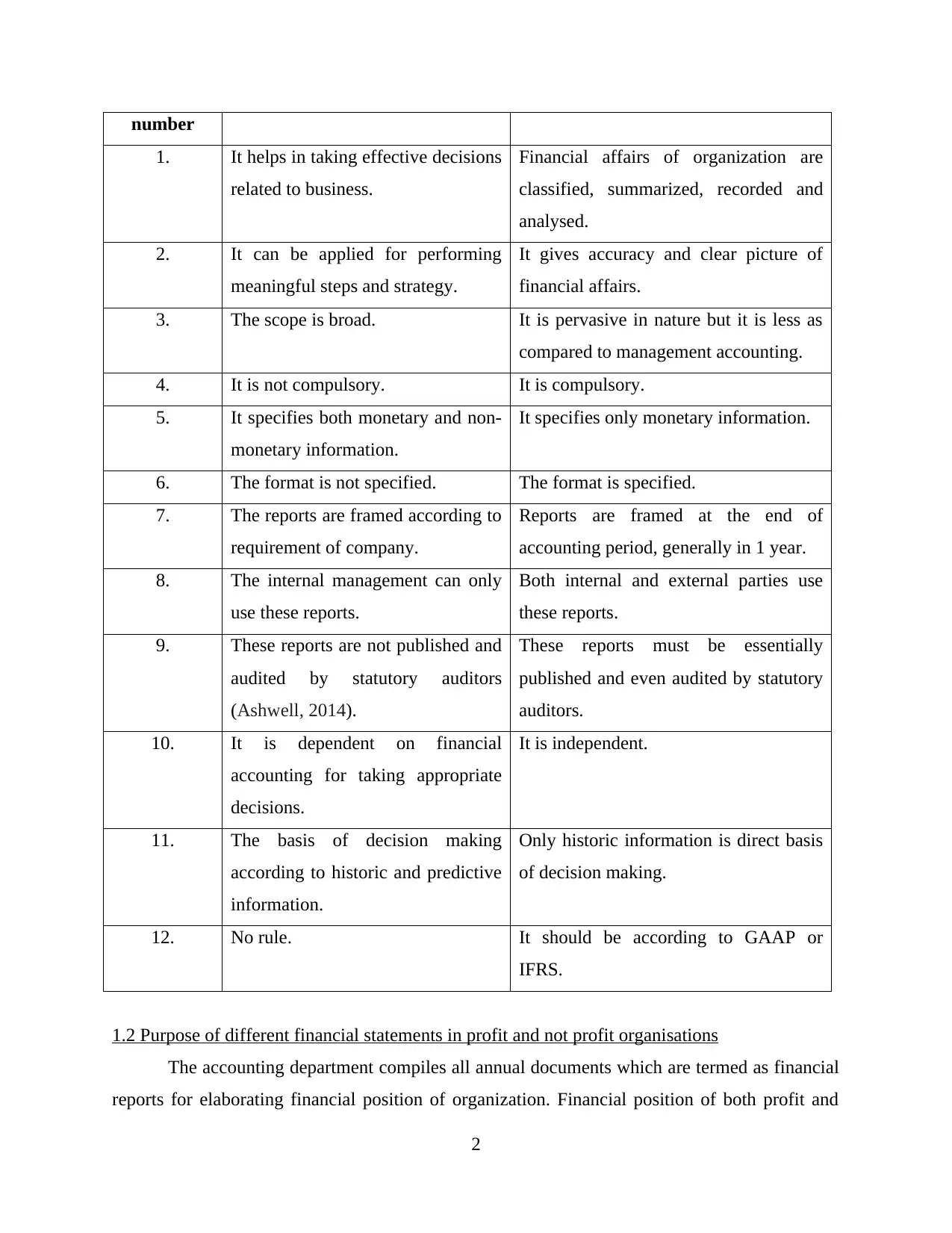
number
1. It helps in taking effective decisions
related to business.
Financial affairs of organization are
classified, summarized, recorded and
analysed.
2. It can be applied for performing
meaningful steps and strategy.
It gives accuracy and clear picture of
financial affairs.
3. The scope is broad. It is pervasive in nature but it is less as
compared to management accounting.
4. It is not compulsory. It is compulsory.
5. It specifies both monetary and non-
monetary information.
It specifies only monetary information.
6. The format is not specified. The format is specified.
7. The reports are framed according to
requirement of company.
Reports are framed at the end of
accounting period, generally in 1 year.
8. The internal management can only
use these reports.
Both internal and external parties use
these reports.
9. These reports are not published and
audited by statutory auditors
(Ashwell, 2014).
These reports must be essentially
published and even audited by statutory
auditors.
10. It is dependent on financial
accounting for taking appropriate
decisions.
It is independent.
11. The basis of decision making
according to historic and predictive
information.
Only historic information is direct basis
of decision making.
12. No rule. It should be according to GAAP or
IFRS.
1.2 Purpose of different financial statements in profit and not profit organisations
The accounting department compiles all annual documents which are termed as financial
reports for elaborating financial position of organization. Financial position of both profit and
2
1. It helps in taking effective decisions
related to business.
Financial affairs of organization are
classified, summarized, recorded and
analysed.
2. It can be applied for performing
meaningful steps and strategy.
It gives accuracy and clear picture of
financial affairs.
3. The scope is broad. It is pervasive in nature but it is less as
compared to management accounting.
4. It is not compulsory. It is compulsory.
5. It specifies both monetary and non-
monetary information.
It specifies only monetary information.
6. The format is not specified. The format is specified.
7. The reports are framed according to
requirement of company.
Reports are framed at the end of
accounting period, generally in 1 year.
8. The internal management can only
use these reports.
Both internal and external parties use
these reports.
9. These reports are not published and
audited by statutory auditors
(Ashwell, 2014).
These reports must be essentially
published and even audited by statutory
auditors.
10. It is dependent on financial
accounting for taking appropriate
decisions.
It is independent.
11. The basis of decision making
according to historic and predictive
information.
Only historic information is direct basis
of decision making.
12. No rule. It should be according to GAAP or
IFRS.
1.2 Purpose of different financial statements in profit and not profit organisations
The accounting department compiles all annual documents which are termed as financial
reports for elaborating financial position of organization. Financial position of both profit and
2
Paraphrase This Document
Need a fresh take? Get an instant paraphrase of this document with our AI Paraphraser
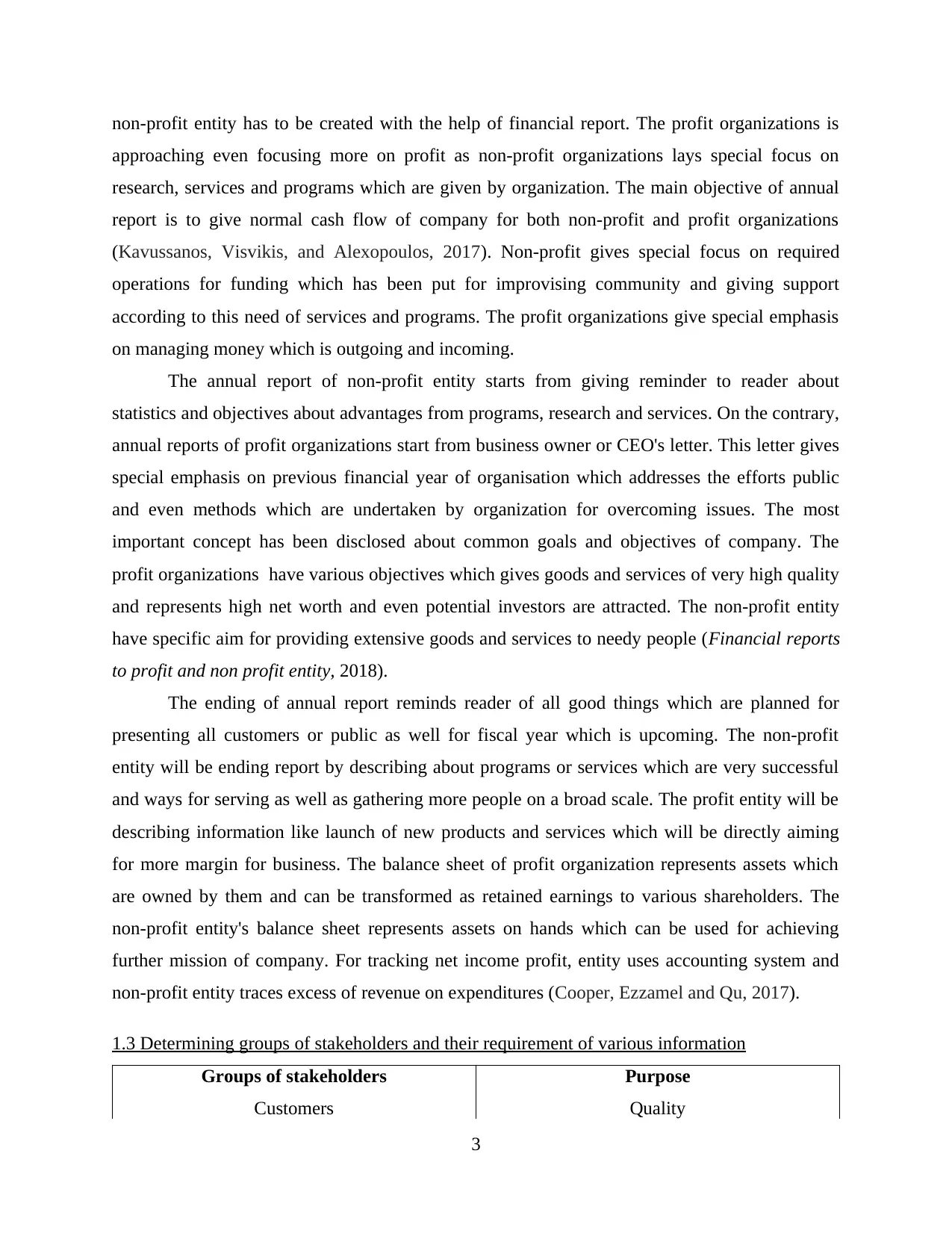
non-profit entity has to be created with the help of financial report. The profit organizations is
approaching even focusing more on profit as non-profit organizations lays special focus on
research, services and programs which are given by organization. The main objective of annual
report is to give normal cash flow of company for both non-profit and profit organizations
(Kavussanos, Visvikis, and Alexopoulos, 2017). Non-profit gives special focus on required
operations for funding which has been put for improvising community and giving support
according to this need of services and programs. The profit organizations give special emphasis
on managing money which is outgoing and incoming.
The annual report of non-profit entity starts from giving reminder to reader about
statistics and objectives about advantages from programs, research and services. On the contrary,
annual reports of profit organizations start from business owner or CEO's letter. This letter gives
special emphasis on previous financial year of organisation which addresses the efforts public
and even methods which are undertaken by organization for overcoming issues. The most
important concept has been disclosed about common goals and objectives of company. The
profit organizations have various objectives which gives goods and services of very high quality
and represents high net worth and even potential investors are attracted. The non-profit entity
have specific aim for providing extensive goods and services to needy people (Financial reports
to profit and non profit entity, 2018).
The ending of annual report reminds reader of all good things which are planned for
presenting all customers or public as well for fiscal year which is upcoming. The non-profit
entity will be ending report by describing about programs or services which are very successful
and ways for serving as well as gathering more people on a broad scale. The profit entity will be
describing information like launch of new products and services which will be directly aiming
for more margin for business. The balance sheet of profit organization represents assets which
are owned by them and can be transformed as retained earnings to various shareholders. The
non-profit entity's balance sheet represents assets on hands which can be used for achieving
further mission of company. For tracking net income profit, entity uses accounting system and
non-profit entity traces excess of revenue on expenditures (Cooper, Ezzamel and Qu, 2017).
1.3 Determining groups of stakeholders and their requirement of various information
Groups of stakeholders Purpose
Customers Quality
3
approaching even focusing more on profit as non-profit organizations lays special focus on
research, services and programs which are given by organization. The main objective of annual
report is to give normal cash flow of company for both non-profit and profit organizations
(Kavussanos, Visvikis, and Alexopoulos, 2017). Non-profit gives special focus on required
operations for funding which has been put for improvising community and giving support
according to this need of services and programs. The profit organizations give special emphasis
on managing money which is outgoing and incoming.
The annual report of non-profit entity starts from giving reminder to reader about
statistics and objectives about advantages from programs, research and services. On the contrary,
annual reports of profit organizations start from business owner or CEO's letter. This letter gives
special emphasis on previous financial year of organisation which addresses the efforts public
and even methods which are undertaken by organization for overcoming issues. The most
important concept has been disclosed about common goals and objectives of company. The
profit organizations have various objectives which gives goods and services of very high quality
and represents high net worth and even potential investors are attracted. The non-profit entity
have specific aim for providing extensive goods and services to needy people (Financial reports
to profit and non profit entity, 2018).
The ending of annual report reminds reader of all good things which are planned for
presenting all customers or public as well for fiscal year which is upcoming. The non-profit
entity will be ending report by describing about programs or services which are very successful
and ways for serving as well as gathering more people on a broad scale. The profit entity will be
describing information like launch of new products and services which will be directly aiming
for more margin for business. The balance sheet of profit organization represents assets which
are owned by them and can be transformed as retained earnings to various shareholders. The
non-profit entity's balance sheet represents assets on hands which can be used for achieving
further mission of company. For tracking net income profit, entity uses accounting system and
non-profit entity traces excess of revenue on expenditures (Cooper, Ezzamel and Qu, 2017).
1.3 Determining groups of stakeholders and their requirement of various information
Groups of stakeholders Purpose
Customers Quality
3
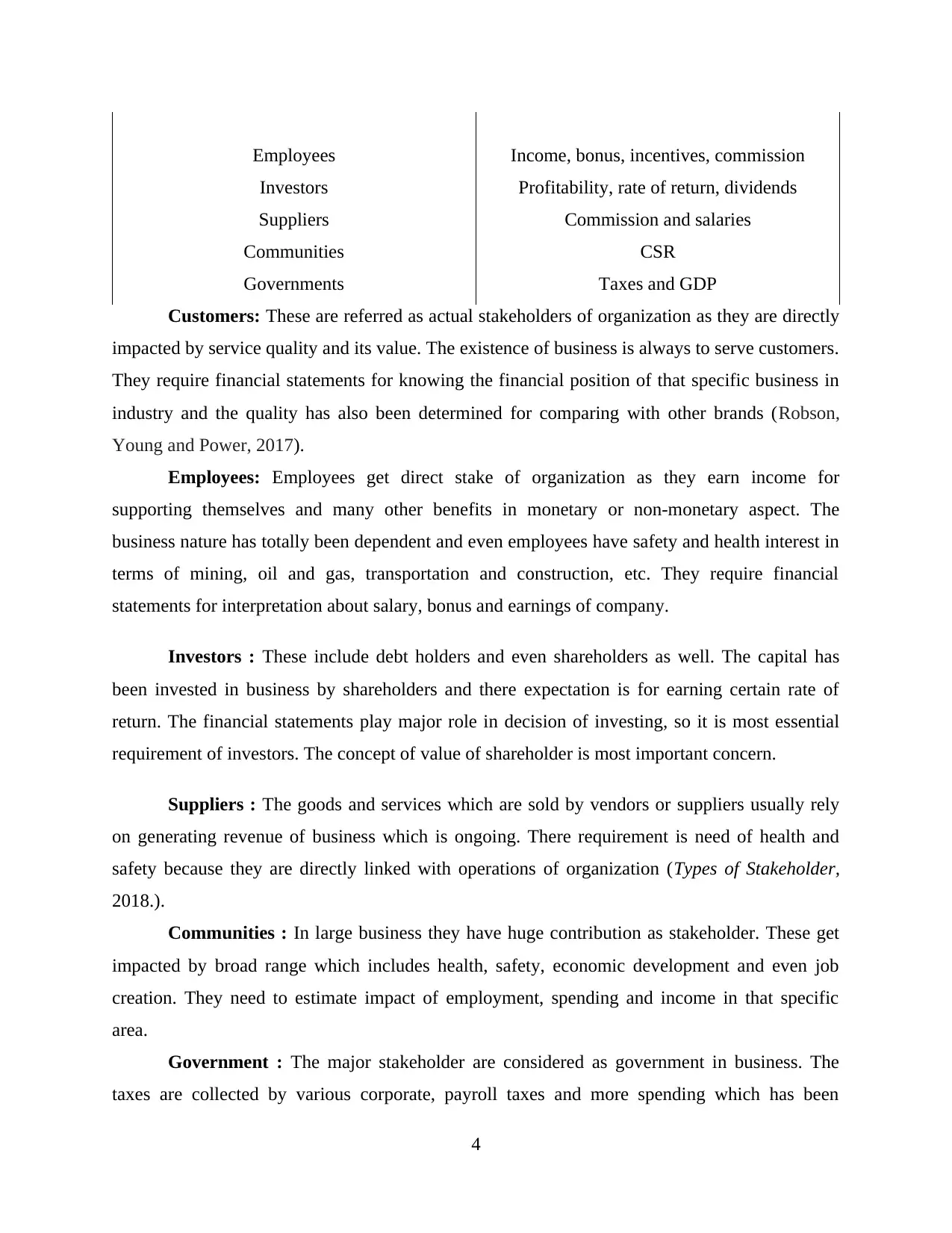
Employees Income, bonus, incentives, commission
Investors Profitability, rate of return, dividends
Suppliers Commission and salaries
Communities CSR
Governments Taxes and GDP
Customers: These are referred as actual stakeholders of organization as they are directly
impacted by service quality and its value. The existence of business is always to serve customers.
They require financial statements for knowing the financial position of that specific business in
industry and the quality has also been determined for comparing with other brands (Robson,
Young and Power, 2017).
Employees: Employees get direct stake of organization as they earn income for
supporting themselves and many other benefits in monetary or non-monetary aspect. The
business nature has totally been dependent and even employees have safety and health interest in
terms of mining, oil and gas, transportation and construction, etc. They require financial
statements for interpretation about salary, bonus and earnings of company.
Investors : These include debt holders and even shareholders as well. The capital has
been invested in business by shareholders and there expectation is for earning certain rate of
return. The financial statements play major role in decision of investing, so it is most essential
requirement of investors. The concept of value of shareholder is most important concern.
Suppliers : The goods and services which are sold by vendors or suppliers usually rely
on generating revenue of business which is ongoing. There requirement is need of health and
safety because they are directly linked with operations of organization (Types of Stakeholder,
2018.).
Communities : In large business they have huge contribution as stakeholder. These get
impacted by broad range which includes health, safety, economic development and even job
creation. They need to estimate impact of employment, spending and income in that specific
area.
Government : The major stakeholder are considered as government in business. The
taxes are collected by various corporate, payroll taxes and more spending which has been
4
Investors Profitability, rate of return, dividends
Suppliers Commission and salaries
Communities CSR
Governments Taxes and GDP
Customers: These are referred as actual stakeholders of organization as they are directly
impacted by service quality and its value. The existence of business is always to serve customers.
They require financial statements for knowing the financial position of that specific business in
industry and the quality has also been determined for comparing with other brands (Robson,
Young and Power, 2017).
Employees: Employees get direct stake of organization as they earn income for
supporting themselves and many other benefits in monetary or non-monetary aspect. The
business nature has totally been dependent and even employees have safety and health interest in
terms of mining, oil and gas, transportation and construction, etc. They require financial
statements for interpretation about salary, bonus and earnings of company.
Investors : These include debt holders and even shareholders as well. The capital has
been invested in business by shareholders and there expectation is for earning certain rate of
return. The financial statements play major role in decision of investing, so it is most essential
requirement of investors. The concept of value of shareholder is most important concern.
Suppliers : The goods and services which are sold by vendors or suppliers usually rely
on generating revenue of business which is ongoing. There requirement is need of health and
safety because they are directly linked with operations of organization (Types of Stakeholder,
2018.).
Communities : In large business they have huge contribution as stakeholder. These get
impacted by broad range which includes health, safety, economic development and even job
creation. They need to estimate impact of employment, spending and income in that specific
area.
Government : The major stakeholder are considered as government in business. The
taxes are collected by various corporate, payroll taxes and more spending which has been
4
⊘ This is a preview!⊘
Do you want full access?
Subscribe today to unlock all pages.

Trusted by 1+ million students worldwide
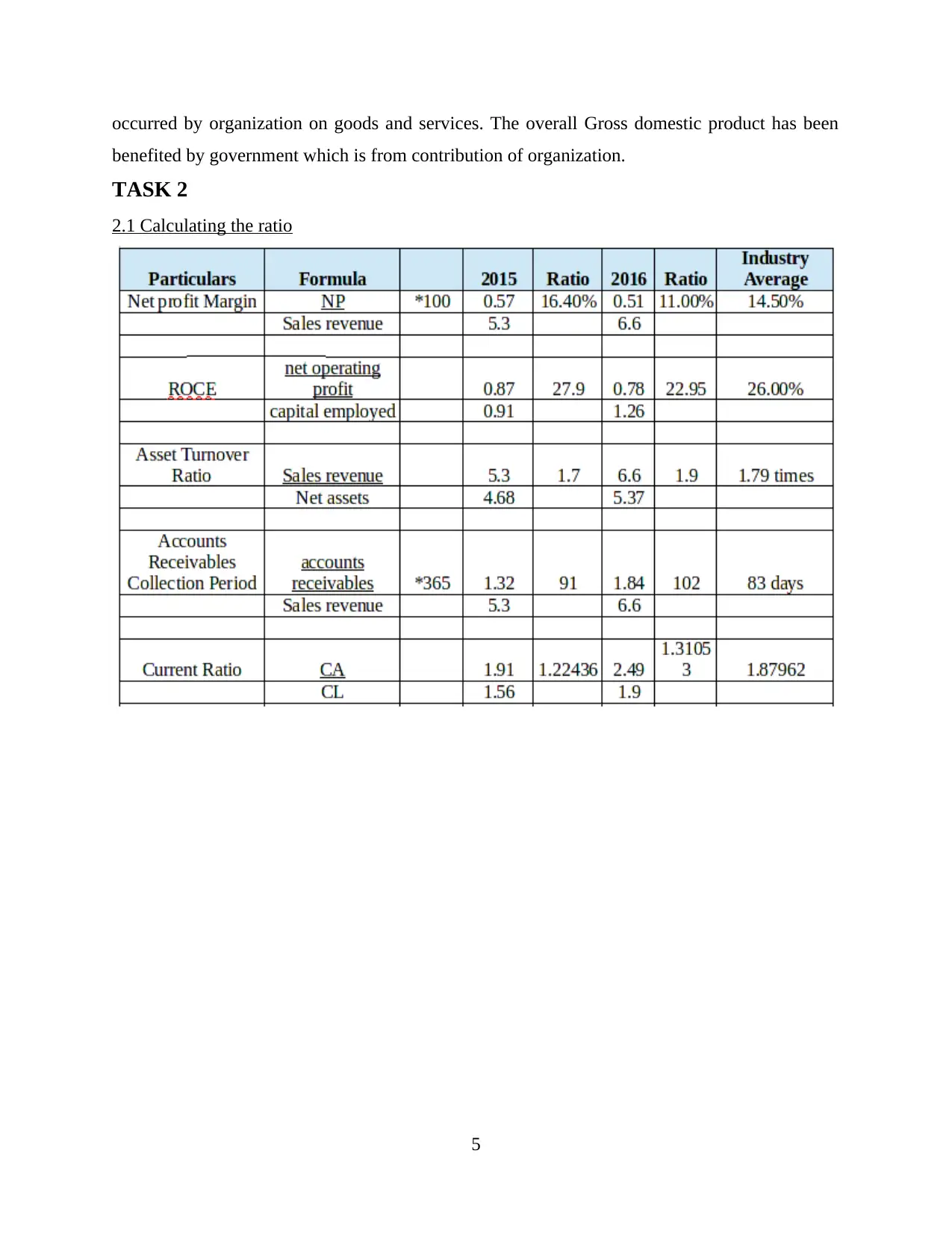
occurred by organization on goods and services. The overall Gross domestic product has been
benefited by government which is from contribution of organization.
TASK 2
2.1 Calculating the ratio
5
benefited by government which is from contribution of organization.
TASK 2
2.1 Calculating the ratio
5
Paraphrase This Document
Need a fresh take? Get an instant paraphrase of this document with our AI Paraphraser
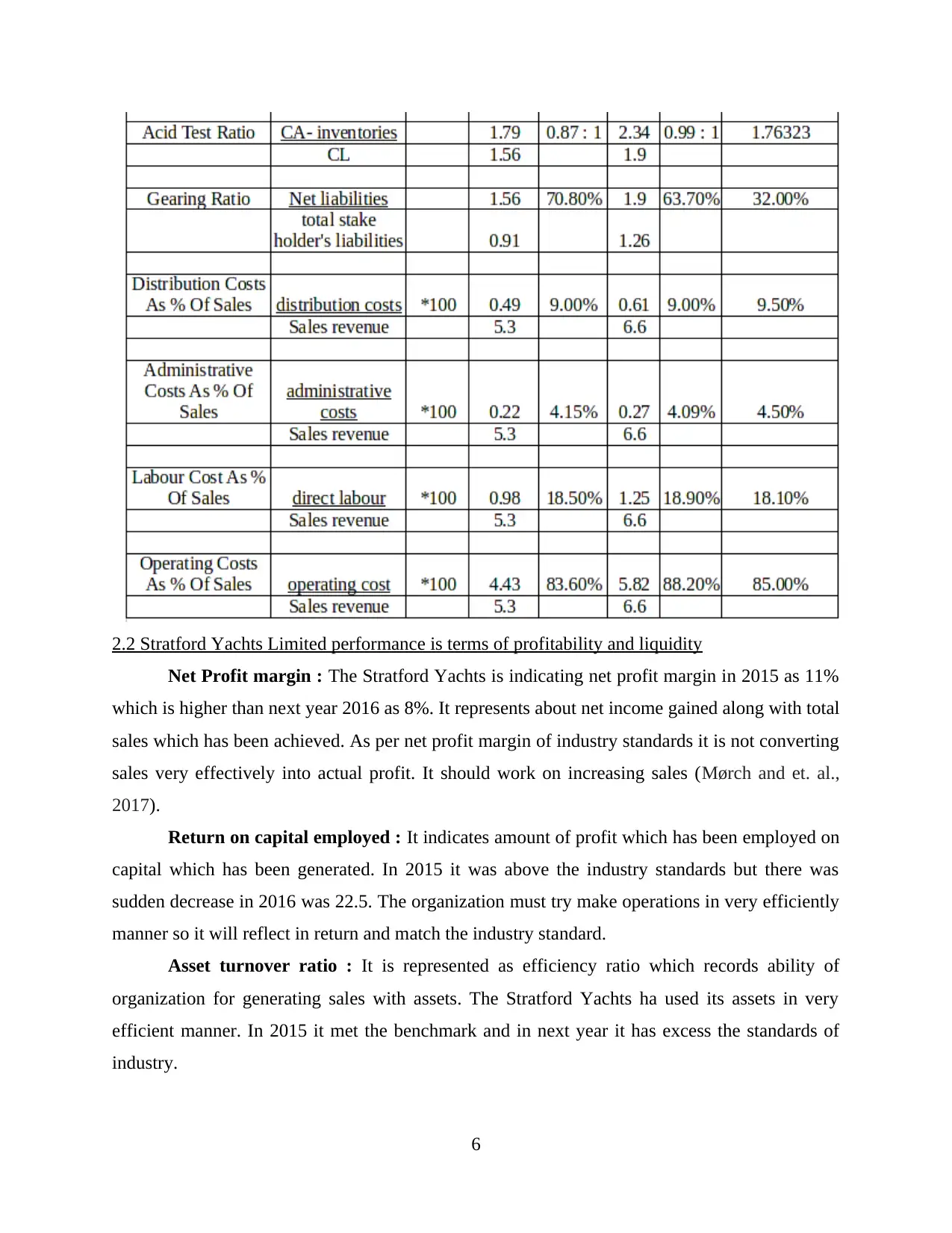
2.2 Stratford Yachts Limited performance is terms of profitability and liquidity
Net Profit margin : The Stratford Yachts is indicating net profit margin in 2015 as 11%
which is higher than next year 2016 as 8%. It represents about net income gained along with total
sales which has been achieved. As per net profit margin of industry standards it is not converting
sales very effectively into actual profit. It should work on increasing sales (Mørch and et. al.,
2017).
Return on capital employed : It indicates amount of profit which has been employed on
capital which has been generated. In 2015 it was above the industry standards but there was
sudden decrease in 2016 was 22.5. The organization must try make operations in very efficiently
manner so it will reflect in return and match the industry standard.
Asset turnover ratio : It is represented as efficiency ratio which records ability of
organization for generating sales with assets. The Stratford Yachts ha used its assets in very
efficient manner. In 2015 it met the benchmark and in next year it has excess the standards of
industry.
6
Net Profit margin : The Stratford Yachts is indicating net profit margin in 2015 as 11%
which is higher than next year 2016 as 8%. It represents about net income gained along with total
sales which has been achieved. As per net profit margin of industry standards it is not converting
sales very effectively into actual profit. It should work on increasing sales (Mørch and et. al.,
2017).
Return on capital employed : It indicates amount of profit which has been employed on
capital which has been generated. In 2015 it was above the industry standards but there was
sudden decrease in 2016 was 22.5. The organization must try make operations in very efficiently
manner so it will reflect in return and match the industry standard.
Asset turnover ratio : It is represented as efficiency ratio which records ability of
organization for generating sales with assets. The Stratford Yachts ha used its assets in very
efficient manner. In 2015 it met the benchmark and in next year it has excess the standards of
industry.
6
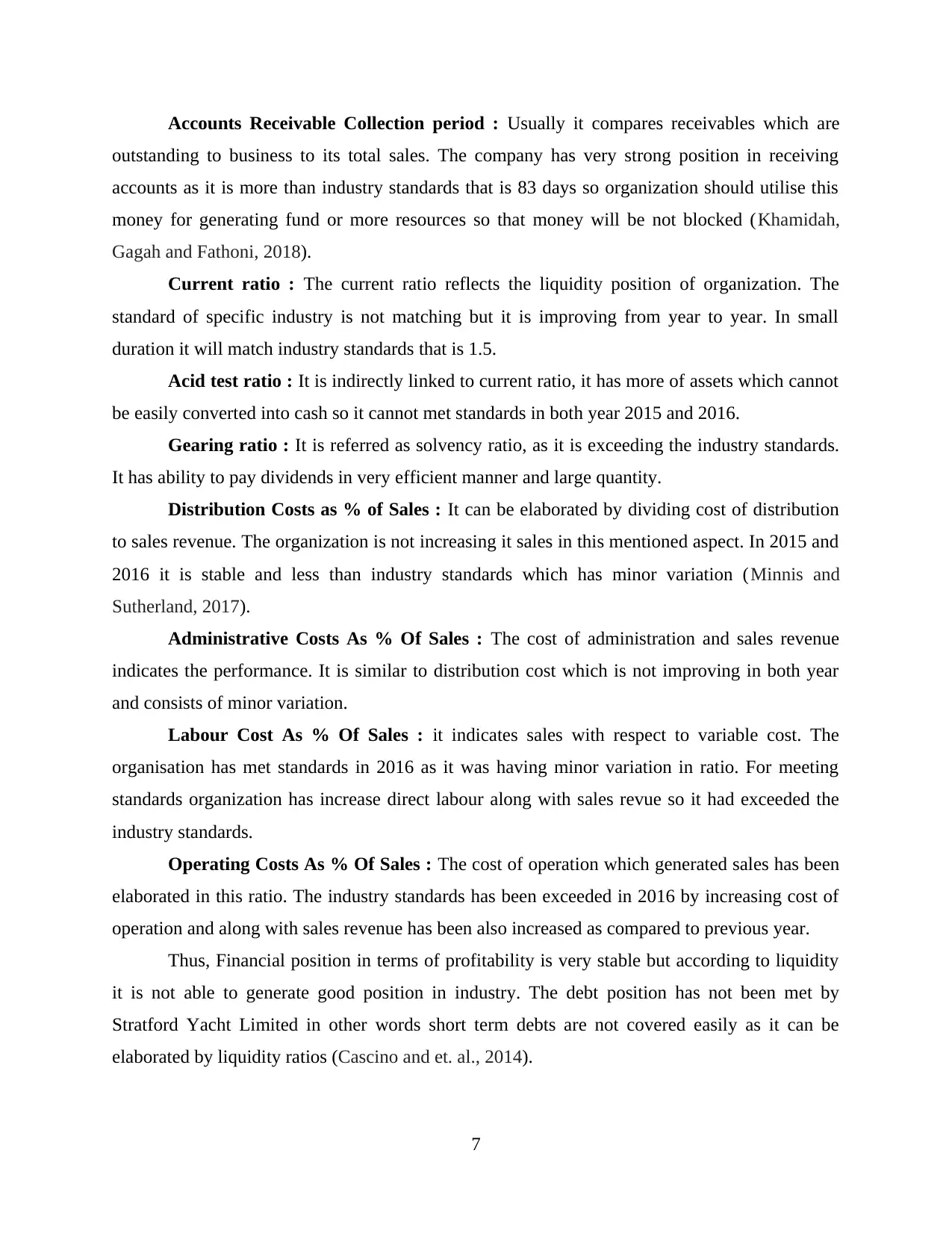
Accounts Receivable Collection period : Usually it compares receivables which are
outstanding to business to its total sales. The company has very strong position in receiving
accounts as it is more than industry standards that is 83 days so organization should utilise this
money for generating fund or more resources so that money will be not blocked (Khamidah,
Gagah and Fathoni, 2018).
Current ratio : The current ratio reflects the liquidity position of organization. The
standard of specific industry is not matching but it is improving from year to year. In small
duration it will match industry standards that is 1.5.
Acid test ratio : It is indirectly linked to current ratio, it has more of assets which cannot
be easily converted into cash so it cannot met standards in both year 2015 and 2016.
Gearing ratio : It is referred as solvency ratio, as it is exceeding the industry standards.
It has ability to pay dividends in very efficient manner and large quantity.
Distribution Costs as % of Sales : It can be elaborated by dividing cost of distribution
to sales revenue. The organization is not increasing it sales in this mentioned aspect. In 2015 and
2016 it is stable and less than industry standards which has minor variation (Minnis and
Sutherland, 2017).
Administrative Costs As % Of Sales : The cost of administration and sales revenue
indicates the performance. It is similar to distribution cost which is not improving in both year
and consists of minor variation.
Labour Cost As % Of Sales : it indicates sales with respect to variable cost. The
organisation has met standards in 2016 as it was having minor variation in ratio. For meeting
standards organization has increase direct labour along with sales revue so it had exceeded the
industry standards.
Operating Costs As % Of Sales : The cost of operation which generated sales has been
elaborated in this ratio. The industry standards has been exceeded in 2016 by increasing cost of
operation and along with sales revenue has been also increased as compared to previous year.
Thus, Financial position in terms of profitability is very stable but according to liquidity
it is not able to generate good position in industry. The debt position has not been met by
Stratford Yacht Limited in other words short term debts are not covered easily as it can be
elaborated by liquidity ratios (Cascino and et. al., 2014).
7
outstanding to business to its total sales. The company has very strong position in receiving
accounts as it is more than industry standards that is 83 days so organization should utilise this
money for generating fund or more resources so that money will be not blocked (Khamidah,
Gagah and Fathoni, 2018).
Current ratio : The current ratio reflects the liquidity position of organization. The
standard of specific industry is not matching but it is improving from year to year. In small
duration it will match industry standards that is 1.5.
Acid test ratio : It is indirectly linked to current ratio, it has more of assets which cannot
be easily converted into cash so it cannot met standards in both year 2015 and 2016.
Gearing ratio : It is referred as solvency ratio, as it is exceeding the industry standards.
It has ability to pay dividends in very efficient manner and large quantity.
Distribution Costs as % of Sales : It can be elaborated by dividing cost of distribution
to sales revenue. The organization is not increasing it sales in this mentioned aspect. In 2015 and
2016 it is stable and less than industry standards which has minor variation (Minnis and
Sutherland, 2017).
Administrative Costs As % Of Sales : The cost of administration and sales revenue
indicates the performance. It is similar to distribution cost which is not improving in both year
and consists of minor variation.
Labour Cost As % Of Sales : it indicates sales with respect to variable cost. The
organisation has met standards in 2016 as it was having minor variation in ratio. For meeting
standards organization has increase direct labour along with sales revue so it had exceeded the
industry standards.
Operating Costs As % Of Sales : The cost of operation which generated sales has been
elaborated in this ratio. The industry standards has been exceeded in 2016 by increasing cost of
operation and along with sales revenue has been also increased as compared to previous year.
Thus, Financial position in terms of profitability is very stable but according to liquidity
it is not able to generate good position in industry. The debt position has not been met by
Stratford Yacht Limited in other words short term debts are not covered easily as it can be
elaborated by liquidity ratios (Cascino and et. al., 2014).
7
⊘ This is a preview!⊘
Do you want full access?
Subscribe today to unlock all pages.

Trusted by 1+ million students worldwide
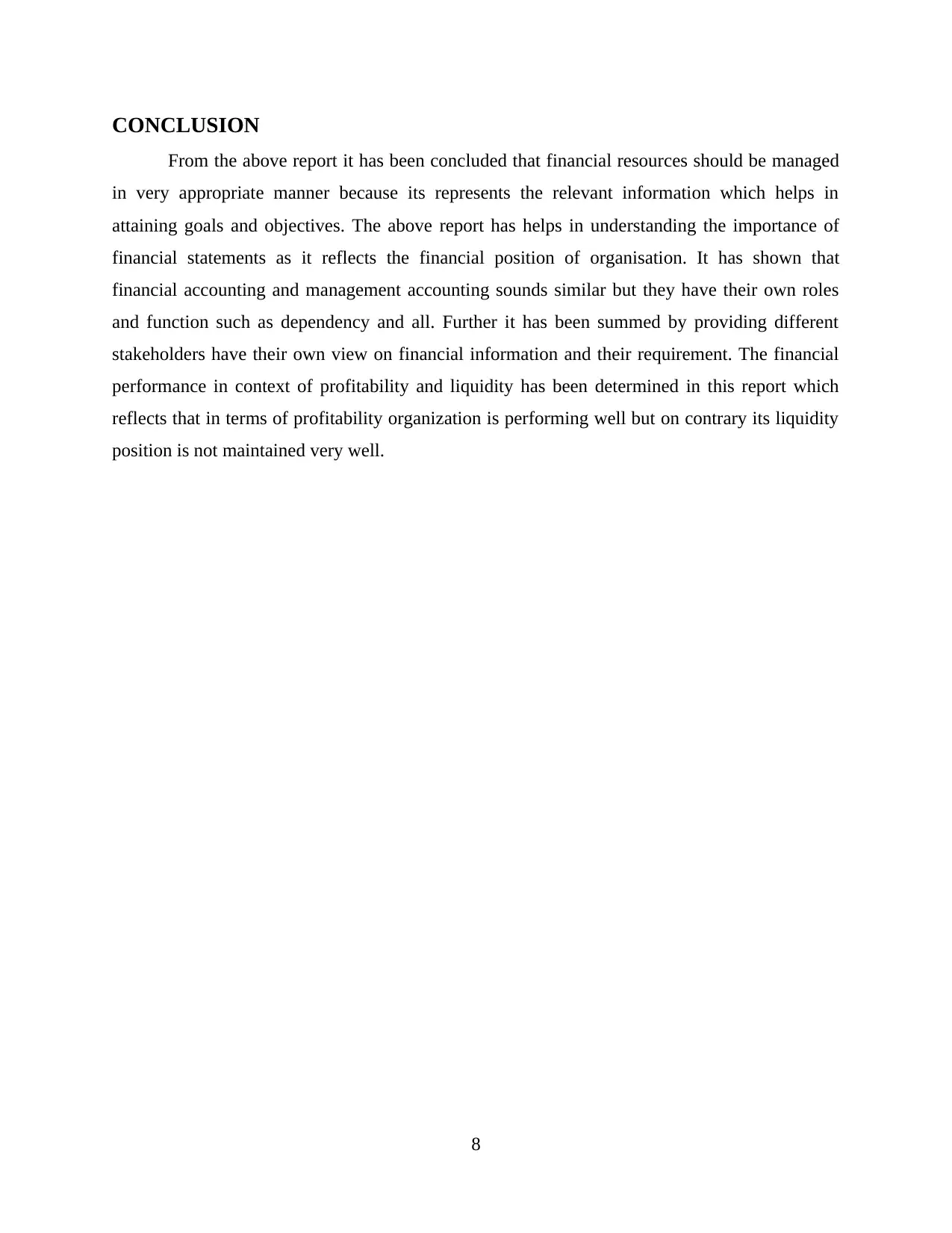
CONCLUSION
From the above report it has been concluded that financial resources should be managed
in very appropriate manner because its represents the relevant information which helps in
attaining goals and objectives. The above report has helps in understanding the importance of
financial statements as it reflects the financial position of organisation. It has shown that
financial accounting and management accounting sounds similar but they have their own roles
and function such as dependency and all. Further it has been summed by providing different
stakeholders have their own view on financial information and their requirement. The financial
performance in context of profitability and liquidity has been determined in this report which
reflects that in terms of profitability organization is performing well but on contrary its liquidity
position is not maintained very well.
8
From the above report it has been concluded that financial resources should be managed
in very appropriate manner because its represents the relevant information which helps in
attaining goals and objectives. The above report has helps in understanding the importance of
financial statements as it reflects the financial position of organisation. It has shown that
financial accounting and management accounting sounds similar but they have their own roles
and function such as dependency and all. Further it has been summed by providing different
stakeholders have their own view on financial information and their requirement. The financial
performance in context of profitability and liquidity has been determined in this report which
reflects that in terms of profitability organization is performing well but on contrary its liquidity
position is not maintained very well.
8
Paraphrase This Document
Need a fresh take? Get an instant paraphrase of this document with our AI Paraphraser
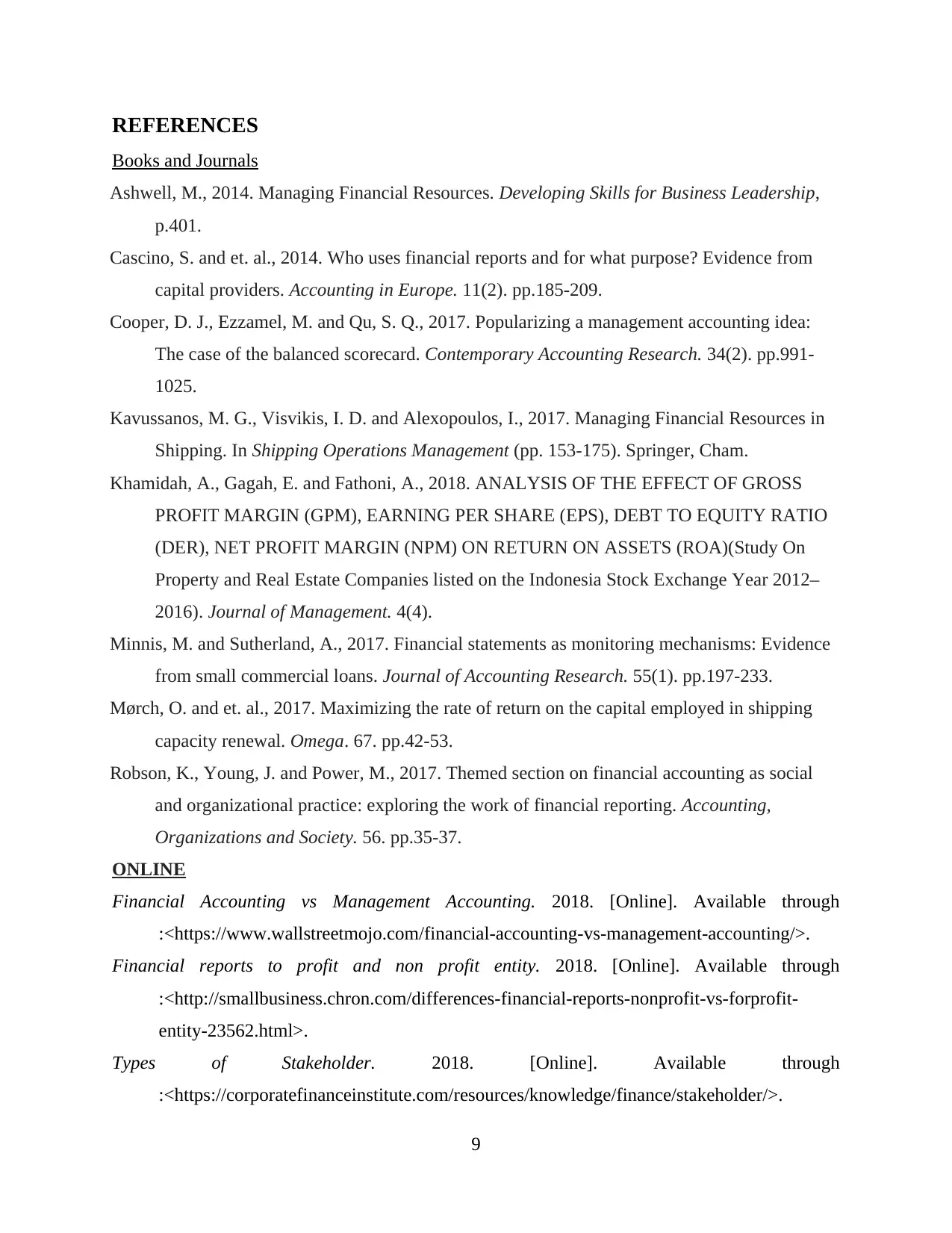
REFERENCES
Books and Journals
Ashwell, M., 2014. Managing Financial Resources. Developing Skills for Business Leadership,
p.401.
Cascino, S. and et. al., 2014. Who uses financial reports and for what purpose? Evidence from
capital providers. Accounting in Europe. 11(2). pp.185-209.
Cooper, D. J., Ezzamel, M. and Qu, S. Q., 2017. Popularizing a management accounting idea:
The case of the balanced scorecard. Contemporary Accounting Research. 34(2). pp.991-
1025.
Kavussanos, M. G., Visvikis, I. D. and Alexopoulos, I., 2017. Managing Financial Resources in
Shipping. In Shipping Operations Management (pp. 153-175). Springer, Cham.
Khamidah, A., Gagah, E. and Fathoni, A., 2018. ANALYSIS OF THE EFFECT OF GROSS
PROFIT MARGIN (GPM), EARNING PER SHARE (EPS), DEBT TO EQUITY RATIO
(DER), NET PROFIT MARGIN (NPM) ON RETURN ON ASSETS (ROA)(Study On
Property and Real Estate Companies listed on the Indonesia Stock Exchange Year 2012–
2016). Journal of Management. 4(4).
Minnis, M. and Sutherland, A., 2017. Financial statements as monitoring mechanisms: Evidence
from small commercial loans. Journal of Accounting Research. 55(1). pp.197-233.
Mørch, O. and et. al., 2017. Maximizing the rate of return on the capital employed in shipping
capacity renewal. Omega. 67. pp.42-53.
Robson, K., Young, J. and Power, M., 2017. Themed section on financial accounting as social
and organizational practice: exploring the work of financial reporting. Accounting,
Organizations and Society. 56. pp.35-37.
ONLINE
Financial Accounting vs Management Accounting. 2018. [Online]. Available through
:<https://www.wallstreetmojo.com/financial-accounting-vs-management-accounting/>.
Financial reports to profit and non profit entity. 2018. [Online]. Available through
:<http://smallbusiness.chron.com/differences-financial-reports-nonprofit-vs-forprofit-
entity-23562.html>.
Types of Stakeholder. 2018. [Online]. Available through
:<https://corporatefinanceinstitute.com/resources/knowledge/finance/stakeholder/>.
9
Books and Journals
Ashwell, M., 2014. Managing Financial Resources. Developing Skills for Business Leadership,
p.401.
Cascino, S. and et. al., 2014. Who uses financial reports and for what purpose? Evidence from
capital providers. Accounting in Europe. 11(2). pp.185-209.
Cooper, D. J., Ezzamel, M. and Qu, S. Q., 2017. Popularizing a management accounting idea:
The case of the balanced scorecard. Contemporary Accounting Research. 34(2). pp.991-
1025.
Kavussanos, M. G., Visvikis, I. D. and Alexopoulos, I., 2017. Managing Financial Resources in
Shipping. In Shipping Operations Management (pp. 153-175). Springer, Cham.
Khamidah, A., Gagah, E. and Fathoni, A., 2018. ANALYSIS OF THE EFFECT OF GROSS
PROFIT MARGIN (GPM), EARNING PER SHARE (EPS), DEBT TO EQUITY RATIO
(DER), NET PROFIT MARGIN (NPM) ON RETURN ON ASSETS (ROA)(Study On
Property and Real Estate Companies listed on the Indonesia Stock Exchange Year 2012–
2016). Journal of Management. 4(4).
Minnis, M. and Sutherland, A., 2017. Financial statements as monitoring mechanisms: Evidence
from small commercial loans. Journal of Accounting Research. 55(1). pp.197-233.
Mørch, O. and et. al., 2017. Maximizing the rate of return on the capital employed in shipping
capacity renewal. Omega. 67. pp.42-53.
Robson, K., Young, J. and Power, M., 2017. Themed section on financial accounting as social
and organizational practice: exploring the work of financial reporting. Accounting,
Organizations and Society. 56. pp.35-37.
ONLINE
Financial Accounting vs Management Accounting. 2018. [Online]. Available through
:<https://www.wallstreetmojo.com/financial-accounting-vs-management-accounting/>.
Financial reports to profit and non profit entity. 2018. [Online]. Available through
:<http://smallbusiness.chron.com/differences-financial-reports-nonprofit-vs-forprofit-
entity-23562.html>.
Types of Stakeholder. 2018. [Online]. Available through
:<https://corporatefinanceinstitute.com/resources/knowledge/finance/stakeholder/>.
9

10
⊘ This is a preview!⊘
Do you want full access?
Subscribe today to unlock all pages.

Trusted by 1+ million students worldwide
1 out of 13
Related Documents
Your All-in-One AI-Powered Toolkit for Academic Success.
+13062052269
info@desklib.com
Available 24*7 on WhatsApp / Email
![[object Object]](/_next/static/media/star-bottom.7253800d.svg)
Unlock your academic potential
Copyright © 2020–2025 A2Z Services. All Rights Reserved. Developed and managed by ZUCOL.





